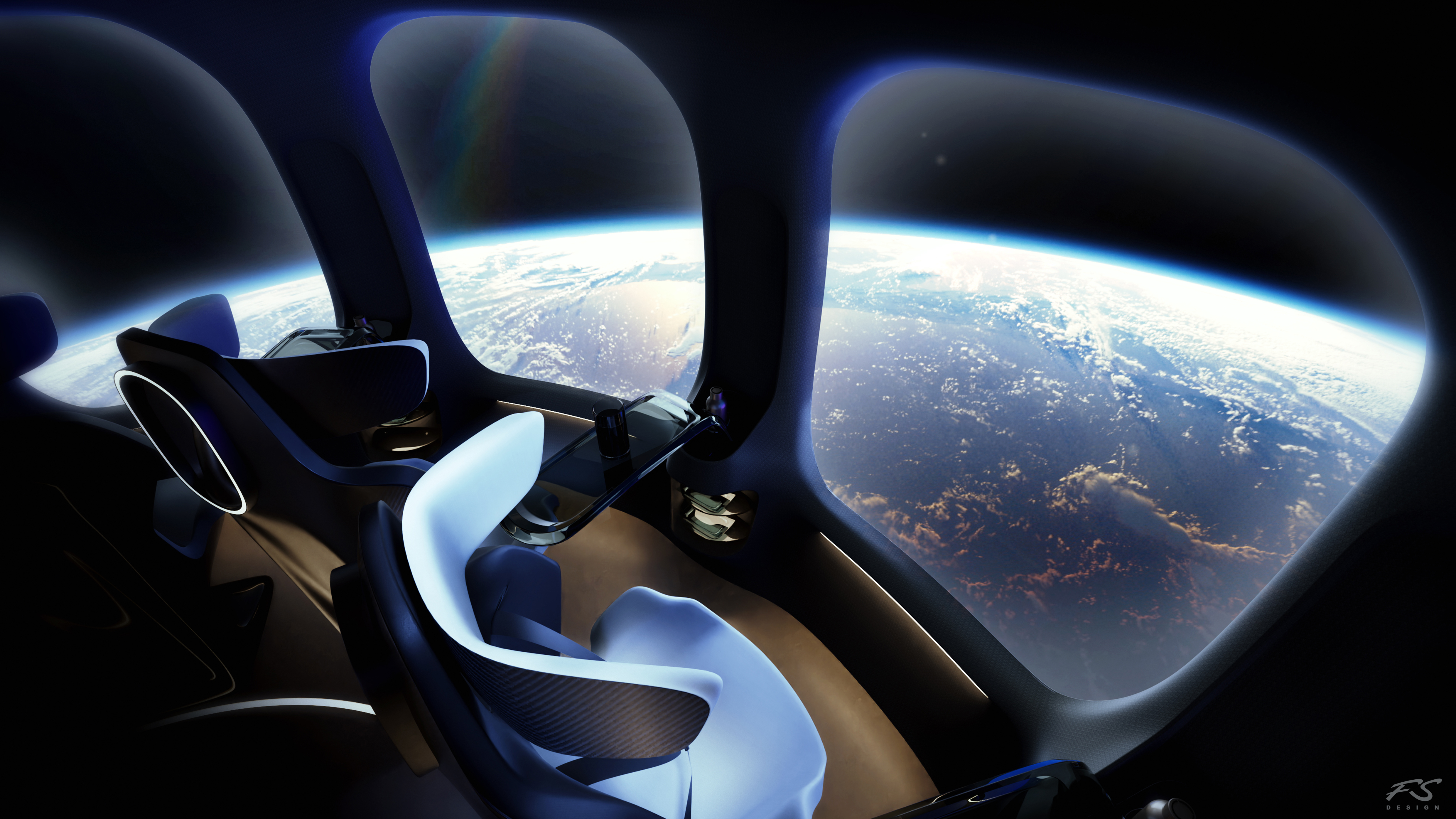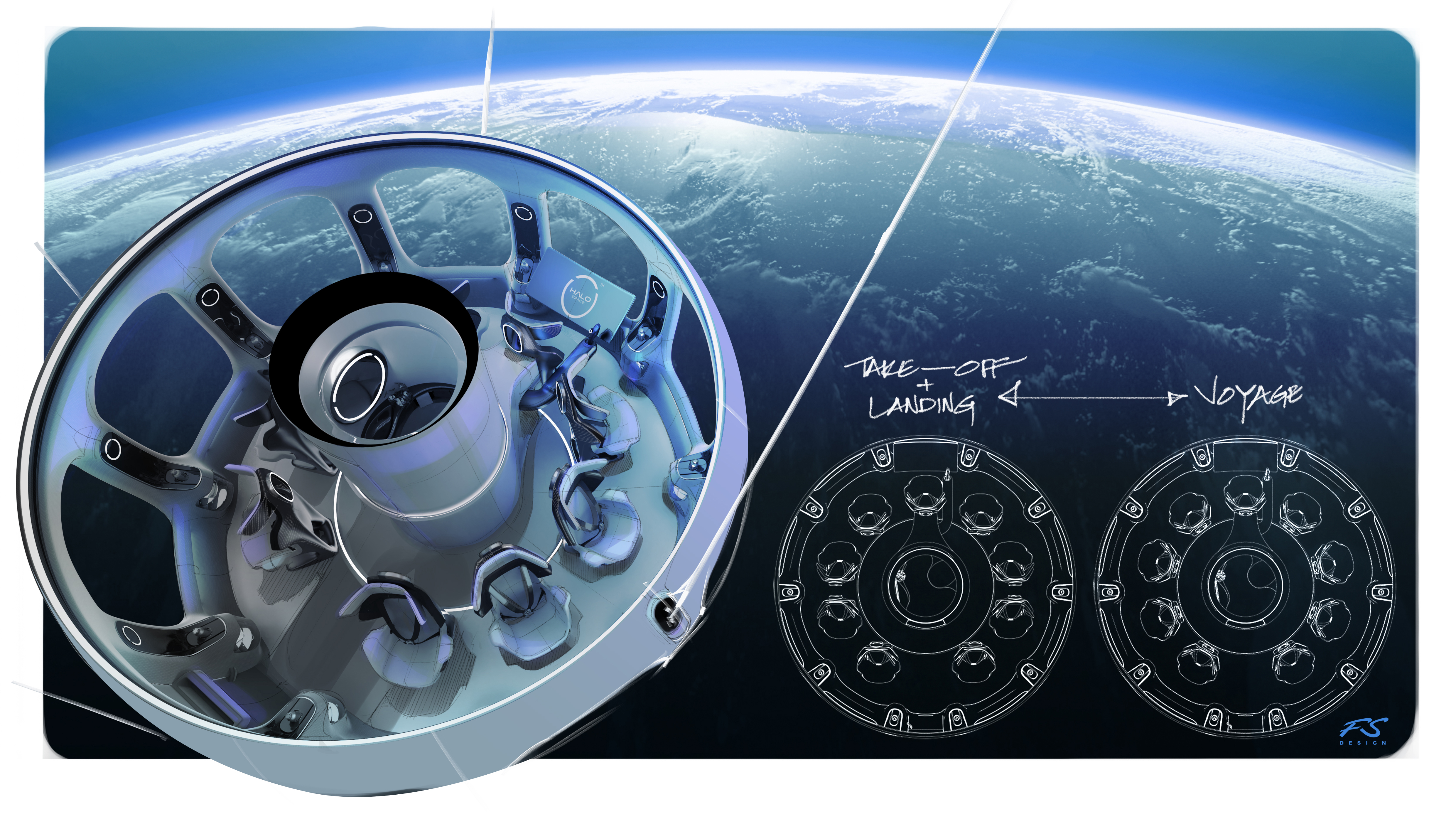HALO Space unveils capsule design for stratospheric space 'glamping'
A Spanish balloon company plans to begin flying paying space tourists in 2026

LONDON — Stratospheric balloon company HALO Space plans to offer aspiring space travelers the space tourism equivalent of glamping. Instead of tight space suits and stomach-churning G-forces typically attached to a rocket flight, the company's pressurized capsule, attached to a helium-filled balloon, will offer comfy swivel seats, giant windows and a selection of fine cuisine.
The Spanish-headquartered firm unveiled the design of the 3.9-ton (3.5 metric tonnes) Aurora capsule at an event in London on Wednesday, April 10, and said it hoped to begin commercial operations in 2026.
Unlike suborbital space tourism companies such as Virgin Galactic and Blue Origin, HALO Space won't be taking passengers high enough to experience weightlessness. The flight will be a rather leisurely affair lasting up to six hours, almost four of which will be spent hovering in the stratosphere some 22 miles (35 kilometers) above Earth's surface. There, high above the cloud tops, passengers will be able to admire the star-studded blackness of space above, as well as the curvature of the planet shrouded in the atmosphere beneath their feet.
"When you talk to astronauts, they tell you that this experience of watching the planet from above is really something unique and extraordinary," HALO Space CEO Carlos Mira said in the press conference. "So far, only 650 humans have had the opportunity to experience this overview effect. But you don’t need to go all the way to space to have it. We hope to offer this experience to 1,000 people by 2030."
HALO Space is one of two companies currently readying its balloon technology to begin commercial operations in the next two years. The other is Florida-based Space Perspective, which revealed a completed test model of their Spaceship Neptune in February. HALO Space said they have conducted five test flights with a mockup and plan to take off for the first crewed test in 2025 before commencing flights with paying passengers a year later.
Both companies hope their propositions will attract a wider customer base than the jerky rocket rides of Blue Origin and Virgin Galactic, which propel daredevil clients on short joy rides to the edge of space and back. Reaching an altitude nearly three times higher than stratospheric balloons, Virgin Galactic and Blue Origin's spacecraft experience several-minute-long spells of microgravity before falling back to Earth.
Breaking space news, the latest updates on rocket launches, skywatching events and more!
At $164,000 per seat, a trip with HALO Space will cost about a third of the price of a Virgin Galactic flight and won't require any advanced medical certifications.
"The take-off will be like being in an elevator," said Mira. "The ascent is soft and gentle, climbing at 12 miles per hour."
The 16-foot-wide (5 meters) and 11.5-foot-tall (3.5 m) capsule will be made of aluminum alloy and composite materials. With an internal space of 30.4 square feet (2.8 square meters), the spaceship could host eight paying passengers, plus a pilot. The internal atmosphere will be maintained by a life-support system similar to that of an aircraft. Yet despite this crammed interior and the extreme environment outside the capsule, passengers should still feel perfectly comfortable and able to relax.
"It's meant to be a sort of a glamping experience," Frank Stephenson, creative director and founder of Frank Stephenson Design who led the design work said at the conference. "It's a high-level experience for these people who are used to flying first class rather than economy."
Stephenson, who had previously worked for high-end car makers including BMW, Ferrari, Maserati and McLaren, said the biggest challenge was keeping the capsule light enough so that it can be safely lifted by the balloon while still making sure every aspect of the interior lives up to the expectations of passengers.
“It's very easy to add weight to things and make it super comfortable," Stephenson said. "It's more difficult to reduce weight, reduce material and still make it feel like a very unique experience."
When fully inflated, the stratospheric balloon will be 460 feet (140 meters) tall, towering over the gleaming space capsule. The balloon is designed to detach from the capsule during descent. The capsule will then be brought down to a landing under a steerable parachute. Mira said the balloon technology is inherently safer than rockets loaded with explosive fuels. It also produces no greenhouse gas emissions, making the experience 100 percent compliant with the most stringent environmental protection standards.
"We are using mature technologies," said Mira. "Balloons in general have been around for more than 200 years. This type of balloon, stratospheric balloons, have been around for almost 100 years. The first human went to the stratosphere on a balloon in 1931."
HALO Space plans to fly from spaceports in the Mojave Desert in the U.S., Spain, Australia and Saudi Arabia. The company is currently working with the U.S. Federal Aviation Administration to receive a license before its first crewed flight next year.

Tereza is a London-based science and technology journalist, aspiring fiction writer and amateur gymnast. Originally from Prague, the Czech Republic, she spent the first seven years of her career working as a reporter, script-writer and presenter for various TV programmes of the Czech Public Service Television. She later took a career break to pursue further education and added a Master's in Science from the International Space University, France, to her Bachelor's in Journalism and Master's in Cultural Anthropology from Prague's Charles University. She worked as a reporter at the Engineering and Technology magazine, freelanced for a range of publications including Live Science, Space.com, Professional Engineering, Via Satellite and Space News and served as a maternity cover science editor at the European Space Agency.


